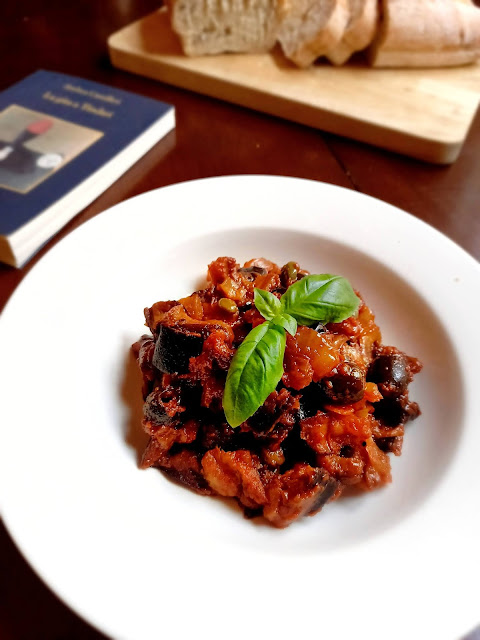Detective Montalbano's caponata - An excursion to Tindari (Andrea Camilleri)
As soon as he opened the refrigerator, he saw it. The Caponata! Fragrant, vivid, generous, a whole deep dish, enough for at least four people. It had been months since his housekeeper Adelina last made some. The bread, in its plastic bag, was freshly baked, bought in the morning. Naturally, spontaneously, the notes of of Aïda's triumphal march came to his lips. Humming, he opened the French window after turning on the lights on the veranda. Yes, it was a cool and breezy night, but nice enough to eat outside. He set a small table, brought out the food, the wine, and the bread, and sat down.
If you haven't read anything by Andrea Camilleri, one of the greatest italian crime novelists (and huge personality), you might have never heard of detective Salvo Montalbano. This charismatic policeman, with his passion for his job, beautiful women and, most of all, food, has become an icon of "sicilianity", embodying many of the often conflicting facets of his island.
An "Excursion to Tindari" is the fifth novel of the Montalbano series, in which the detective investigates the connection between the death of a sketchy depraved character and the disappearance of an old couple who lives in the same building, after they left for a daytrip to Tindari's sanctuary. The city they decided to visit is an ancient greek colony, and took the name of Tyndaris in honor of the putative father of Helen of Troy and the Dioscuri, Castor and Pollux, but it's the Sanctuary of the black Madonna the real reason why hundreds of tourists and worshippers face the steep climb to the top of the hill every week.
Unfortunately, that's about what I feel comfortable saying about the book, because it's such a good crime fiction story that I don't want to risk spoiling anything for you. So let's focus on something rather important for this blog: food.
Food is paramount in Montalbano's saga, its smells and colours are used to describe emotions, personalities, and the overall atmosphere of the scenes. In the one I quoted, it's the relief of coming back home after days of work and frustration and finding one of the most delicious sicialian comfort food, the aubergines caponata.
The original ancestor of caponata was a very simple dish consumed above all by the less affluent classes in anctien Roman times. Only during the Spanish domination of Sicily, it became an aristocratic dish, being enriched with crustaceans, octopus and different types of fish. The first version of the caponata a little closer to today's one can be found in the culinary treatise "Theoretical-practical cuisine with corresponding answer" by the cook and scholar Ippolito Cavalcanti (1837). According to him, the caponata was prepared with toasted slices of bread soaked in oil, white vinegar, salt and pepper. Even at the time of Cavalcanti the caponata recipe was still clearly very distant from the current one, and the only common element between the two recipes, is the sweet and sour sauce. Most likely, the transition from one recipe to another, happened as an attempt to reproduce a dish of the wealthy classes using poorer and easily available ingredients.
The recipe that I present to you today is very simple and comes directly from ... my father.
This is one of the ways my family makes caponata, though sometimes we make a few variations that also include peppers or other vegetables, but this is definitely my favorite one. Don't let the initial steps scare you, the result is worth it.
Ingredients
4 black aubergines
1/2 large white onion
2 celery
1/2 can of peeled tomatoes
1 tablespoon of salted capers (desalted)
150 g of green olives in brine (pitted)
q.s. extra virgin olive oil
q.s. peanut oil (for frying)
q.s. salt
1/2 glass of "good" vinegar (preferably white)
3 tablespoons of sugar
Cut the aubergines into cubes and put them in salt for at least an hour in a colander, in the sink.
In the meantime, prepare the sauce: wash the celery, cut it into chunks and put it in a pan, add the chopped onion and sauté everything with plenty of extra virgin olive oil. Then add the capers - well rinsed from the salt, the olives - whole- and finally the peeled tomatoes or, alternatively, the tomato sauce. Season with salt and cook over low heat, until you get a thick and tasty sauce. Before removing it from the heat, add the sugar and vinegar to make it "sweet and sour", according to your taste.
Now rinse the aubergines with a clean cloth and fry them in hot and abundant oil, this way they will absorb very little oil. Drain them and place them on a tray with absorbent kitchen paper. Finally, add the aubergines to the caponata sauce previously prepared - off the heat! Mix and let it cool completely. Traditionally, we leave it in the fridge for a few hours before serving.
Don't forget some good freshly baked bread to go with it, just like Montalbano.
Let me know if you try this recipe. In the meantime, take care, be safe and keep reading!







1 Comments
That's awesome! It looks lovely!
ReplyDelete